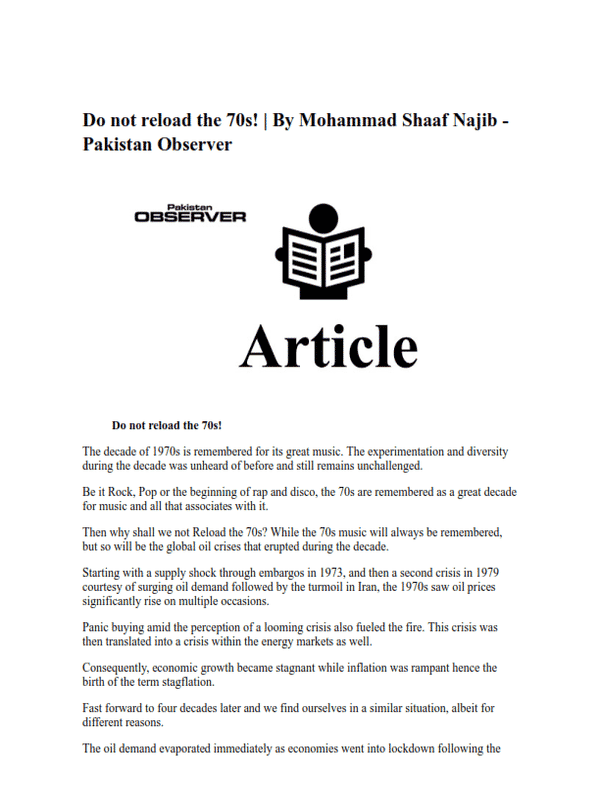
Pakistan Institute of Development Economics
- Home
Our Portals
MenuMenuMenuMenuMenuMenuMenu - ResearchMenuMenuMenuMenuMenuMenuMenu
- Discourse
- The PDR
- Our Researchers
- Academics
- Degree Verification
- Thesis Portal
- Our Portals
Do not reload the 70s!
The decade of 1970s is remembered for its great music. The experimentation and diversity during the decade was unheard of before and still remains unchallenged.
Be it Rock, Pop or the beginning of rap and disco, the 70s are remembered as a great decade for music and all that associates with it.
Then why shall we not Reload the 70s? While the 70s music will always be remembered, but so will be the global oil crises that erupted during the decade.
Starting with a supply shock through embargos in 1973, and then a second crisis in 1979 courtesy of surging oil demand followed by the turmoil in Iran, the 1970s saw oil prices significantly rise on multiple occasions.
Panic buying amid the perception of a looming crisis also fueled the fire. This crisis was then translated into a crisis within the energy markets as well.
Consequently, economic growth became stagnant while inflation was rampant hence the birth of the term stagflation.
Fast forward to four decades later and we find ourselves in a similar situation, albeit for different reasons.
The oil demand evaporated immediately as economies went into lockdown following the spread of COVID pandemic, presenting a massive demand and price shock to the global oil market.
When global economic activity restarted, the demand rose sharply once again pushing the oil prices up and coupled with various supply issues and persisting inflation, the oil prices rose sharply touching almost USD 130 per barrel.
The imminent threat of an oil prices led crisis might have been thwarted for now, particularly with the US decision to use nearly one-third of its strategic reserves over a period of next six months.
This has resulted in a demand reduction in global market thus bringing the price down to under USD 110 per barrel.
Global inflation though still persists, and is expected to remain between three to four percent throughout 2022 and 2023 while the world economy growth is also expected to slow down during this period.
Summing, the world could be on verge of stagflation once again and a potential oil prices crisis will make things only worse.
It is important to note that the increase in oil prices does not have just a onetime impact, instead the second round of oil-led inflation is more worrisome.
The second round refers to the inflation in commodities where oil is used as an input product e.g.energy etc.
The inflation in these commodities occurs with a lag or delay compared to oil inflation, thus any rise in oil prices that perseveres for a longer period will have much long-lasting impact.
The world has not yet fully recovered from the economic impact of COVID and subsequent lockdowns and the world economies individually as well as collectively will not be able to sustain another major shock this soon.
The US use of strategic reserves for six months has given the global actors a slight cushion and an opportunity to find a lasting solution to this issue.
The threat of the crisis cannot be avoided by the actions of just one country, instead the world needs to act together.
It is now important for the world leaders to sit together and devise a strategy and plan that resolves the issues surrounding the oil pricing thus bringing it down to tolerable levels for all economies.
Resolving the Russia-Ukraine conflict will also go a long way in aiding the efforts to prevent any such crisis, while measures must be taken to resolve issues with other oil exporting countries currently facing sanctions such as Iran.
This will not only provide immediate global relief but also prove beneficial in the long run as well.
In case where issues surrounding the oil-prices are not proactively resolved and there is a sharp rise seen again in the prices, it could result in massive demand destruction worldwide.
Oil and other commodities influenced by oil prices will gradually start becoming unaffordable for economies who will have to raise their policy rates as well to fight inflation and curtailing demand both at the same time.
Central Banks either have already started tightening their monetary policy or are on the brink of doing so.
Any other crisis in coming months or year would need central banks to be more aggressive in their approach to the extent that it might end up destructive for economies and economic activity.
High inflation and low economic activity will have long lasting impacts making it difficult for the world to recover from.
In Pakistan’s context, the economy is already treading on a thin rope with regards to these parameters.
Inflation continues to remain high, while with continued depreciation of currency the external sector continues to worsen.
In case of any further global crisis, the impact to Pakistan could be one of the worst in the world causing a significant rollback to our economy.
Following the earlier austerity and demand management policies and then the economic crisis during COVID times, Pakistan’s economy has barely started breathing again through various targeted policies of the government.
Any new crisis could prove to be highly detrimental and destructive for any and all the recovery made by the country in recent years, thus making it even more important for Pakistan to avoid any such crisis.
Concluding, the world needs to act and it needs to act sooner rather later. It is highly essential that we avoid the situations the world has been through in the past. Let’s not reload the 70s (maybe with an exception to the music).
—The writer is Research Fellow, Pakistan Institute of Development Economics, Islamabad. Views expressed are his own and do not express views or opinions of PIDE.



